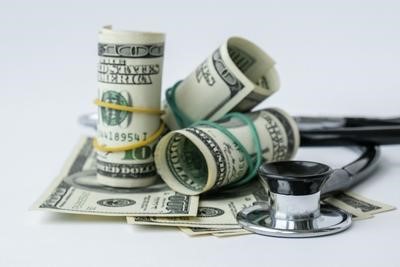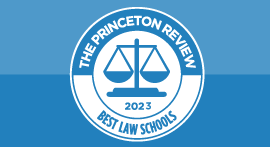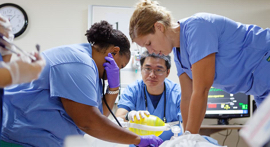
Medical school is an expensive and challenging endeavor , but how much is medical school? According to the AAMC, the median four-year cost of public medical schools is $268,476 for resident students, while students at private medical schools pay a median of $363,836. However, the rewards of becoming a doctor can be great. There are many different costs for attending medical school, from tuition and fees to books and materials to living expenses and more. However, there are various financial aid options available to help make medical school more affordable. Despite the costs, there is a significant potential return on investment of a medical school education and how it can help you achieve your career goals. There are many factors to the costs of medical school, including:
- Tuition and Fees
- Textbooks and Supplies
- Living Expenses
- Other Costs
Tuition and Fees: The cost of attendance for medical school varies widely depending on whether you attend a public or private medical school. According to the Association of American Medical Colleges (AAMC), the average cost of tuition and fees per academic year is upwards of $41,000 for in-state students at public medical schools and $58,000 for out-of-state students. Private medical schools have an average tuition and fees cost upwards of $60,000.
Textbooks and Supplies: In addition to tuition and fees, medical students must also purchase textbooks and supplies. The AAMC estimates that the average cost of textbooks and supplies for the first year of medical school is $1,266.
Living Expenses: Medical students must also consider the cost of living expenses, including housing, food, transportation, and other personal expenses. The AAMC estimates that the average cost of living expenses for the first year of medical school is $27,200.
Other Costs to Consider: Other costs to consider when attending medical school include application fees, travel expenses for interviews, and the cost of medical equipment such as stethoscopes and lab coats.
Financial Aid Options for Medical School
Fortunately, there are several financial aid options available to help make medical school more affordable.
Scholarships and Grants: Medical students can apply for scholarships and grants from a variety of sources, including the federal government, private organizations, and medical schools themselves. The AAMC offers a Fee Assistance Program that provides financial assistance to eligible applicants for MCAT exams, medical school applications, and more.
Federal Loans: Medical students can also apply for federal student loans through the Free Application for Federal Student Aid (FAFSA). These loans typically have lower interest rates and more flexible repayment options than private loans.
Private Loans: Private loans are also an option for medical students, but they often have higher interest rates and less favorable repayment terms than federal loans.
Loan Repayment Programs: After graduation, medical students may be eligible for loan repayment programs that offer financial assistance in exchange for working in underserved areas or in certain medical specialties.
The Return on Investment of a Medical School Education
While the cost of medical school can be daunting, the potential return on investment is significant.
Average Salaries for Medical Professionals: According to the Bureau of Labor Statistics, the median annual salary for physicians and surgeons was $208,000 in May 2020. Other medical professionals, such as nurses and physician assistants, also earn competitive salaries.
Job Growth and Opportunities: The healthcare industry is projected to add more jobs than any other industry between 2019 and 2029, according to the Bureau of Labor Statistics. This means that there will be plenty of job opportunities for medical professionals in the coming years.
Non-Monetary Benefits of a Medical Career: In addition to financial rewards, a career in medicine can also be personally fulfilling. Medical professionals have the opportunity to make a positive impact on the lives of their patients and contribute to the greater good.
Tips for Making Medical School More Affordable
Here are some tips for making medical school more affordable:
Consider Alternative Programs: Some medical schools offer accelerated programs that allow students to complete their education in less time and at a lower cost.
Apply for Scholarships and Grants: As mentioned earlier, there are many scholarships and grants available to medical students. Be sure to research and apply for as many as possible.
Look for Part-Time Work or Paid Internships: Working part-time or participating in paid internships can help offset the cost of tuition and living expenses.
How much is medical school? The cost of attending medical school can be quite heavy, but the potential return on investment is also significant. By taking advantage of financial aid options and making smart financial decisions, medical students can make their education more affordable. Pursuing a career in medicine can be personally and financially rewarding, and we encourage anyone with a passion for healthcare to consider it as a viable career option.
Explore Graduate Programs for You
Explore our featured graduate schools & programs to find those that both match your interests and are looking for students like you.
Best Law Schools
Check out our complete list of 168 law schools, based on surveys of school administrators and over 17,000 students.
Search for Medical Schools
Visit our Med School Hub to explore med schools with our ‘Find Your Med School’ filtered search or visit our Med School Advice pages for info about good MCAT scores or interview question prep.

Find MBA Programs Matched to Your Interests
Explore our featured business schools to find those that are looking for students like you.
Explore Graduate Programs for You
Explore our featured graduate schools & programs to find those that both match your interests and are looking for students like you.
Best Law Schools
Check out our complete list of 168 law schools, based on surveys of school administrators and over 17,000 students.
Search for Medical Schools
Visit our Med School Hub to explore med schools with our ‘Find Your Med School’ filtered search or visit our Med School Advice pages for info about good MCAT scores or interview question prep.

Find MBA Programs Matched to Your Interests
Explore our featured business schools to find those that are looking for students like you.
Explore Graduate Programs for You
Explore our featured graduate schools & programs to find those that both match your interests and are looking for students like you.
Best Law Schools
Check out our complete list of 168 law schools, based on surveys of school administrators and over 17,000 students.
Search for Medical Schools
Visit our Med School Hub to explore med schools with our ‘Find Your Med School’ filtered search or visit our Med School Advice pages for info about good MCAT scores or interview question prep.

Find MBA Programs Matched to Your Interests
Explore our featured business schools to find those that are looking for students like you.


